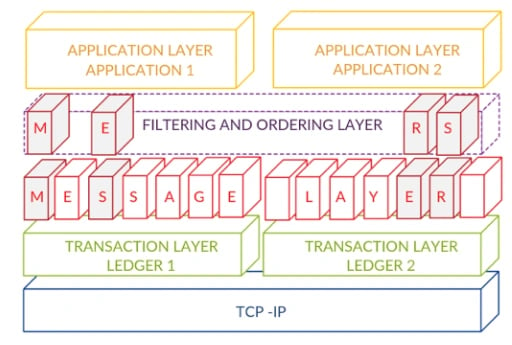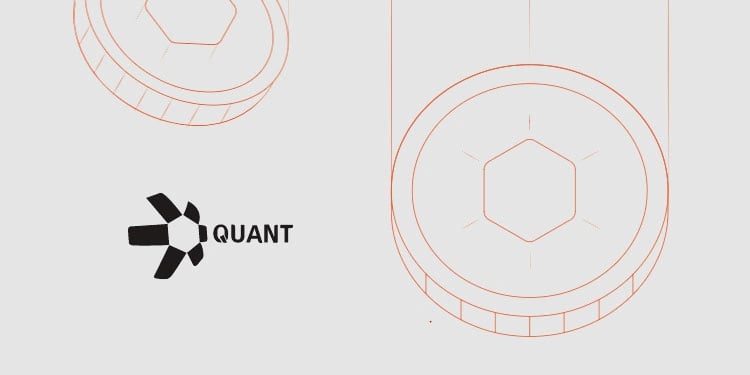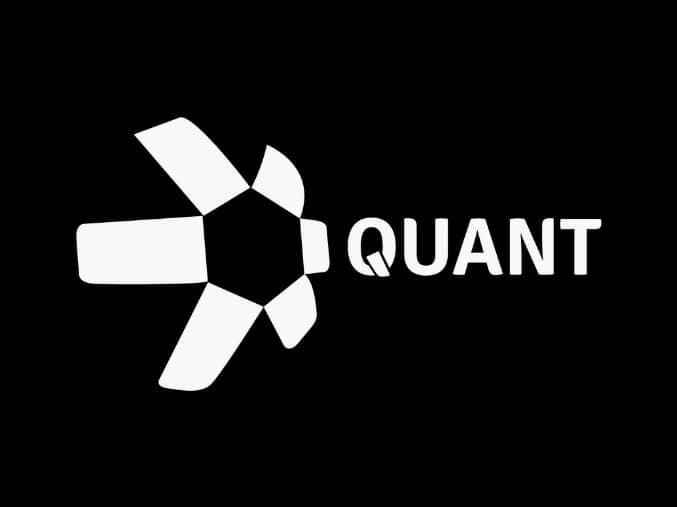订阅 wiki
Share wiki
Bookmark
Quant Network
Quant Network
Quant Network 是一个开源通信协议,旨在将企业和开发者与多个分布式账本技术 (DLT) 同时连接起来。它是一个区块链网络,被誉为第一个区块链操作系统,可在全球范围内桥接区块链,而不会干扰连接的分布式账本的效率和其他属性。 [1]
概述
Quant Network 由 Gilbert Verdian 于 2015 年创立,旨在解决日益增长的区块链互操作性问题,提供了一种高效且安全的方式与不同的 DLT 进行通信。 [11]
Quant (QNT) 主要用于释放区块链技术的潜力,这些潜力之前被分散的身份和分布式账本的个体化进展所掩盖。Quant 的网络被归类为互操作性 区块链 平台,并由其同名的 加密货币 Quant (QNT) 提供支持。企业和开发者可能不需要购买 QNT 代币,但许可证和其他相关费用的支付必须以 QNT 代币进行。 [2][5]
Quant Network 通过 Overledger 运行,Overledger 是一种 DLT 操作系统,充当多个 区块链 的 API 网关。Overledger 支持多个区块链,如 比特币、以太坊、Hyperledger Fabric、R3 Corda 和 BNB Chain,使开发者能够轻松构建多链 去中心化应用程序 (mDApps)。 [11][12]
Quant Network 使用其原生 加密货币 QNT 运行,QNT 是一种 ERC-20 代币,但独立于 区块链。QNT 供开发者用于在 Overledger 平台上构建,而最终用户需要 QNT 才能访问 mDApps 和 Overledger 生态系统。 [11][12]
历史
Quant 由创始人 Gilbert Verdian、Colin Paterson 和 Paolo Tasca 于 2018 年首次宣布并推出。Verdain 作为知名网络安全专家的声誉,曾设立英国金融投资公司 (UKFI) 并与美国联邦储备委员会合作,极大地促进了 Quant Network 进入市场。 [10]
2018 年 4 月,他们通过 首次代币发行 (ICO) 筹集了 1100 万美元,可能达到 3690 万美元的硬顶。Quant 的团队烧毁了募资活动中剩余的代币,总计超过 950 万个 QNT。 [8][9]
2021 年 9 月 8 日,Overledger 的一项重大更新,Overledger 2.0.5 版本发布。该更新实现了多个领先生态系统的桥接,支持各种稳定币、DeFi、NFT 和 ERC-20/ERC-721 资产。 [21][22]
2022 年 8 月 4 日,Overledger 2.2.12 发布,其中包含新的 Overledger Tokenise 功能,使用户可以更轻松地在受支持的网络上创建、部署和管理安全、可互操作的代币和数字资产。 [23]
效用
通过Quant代币,Quant Network的用户可以访问该平台的服务和用例。只有在使用QNT支付许可和平台费用后,他们才能使用Quant的区块链操作系统(Overledger)。开发者、企业、合作伙伴或金融机构可以利用Overledger构建去中心化的多链应用程序(MApps)。作为回报,他们必须为MApp解决方案质押预定数量的QNT代币才能运行。[4]
Quant的生态系统通常通过将代币锁定在智能合约中或将其转移到国库来处理用户访问费用。当用户购买Quant Network上的任何服务时,QNT将从流通中取出,锁定在一个独特的智能合约中,并在订阅到期时释放。或者,当用户购买许可证以在网络上创建任何内容时,加密货币可能只是被转移到国库。[4]
基础设施
Quant Network 使用一种名为 Overledger 的基础设施,它作为 API 网关运行,支持多个分布式账本,允许开发者创建 mDApp。
Overledger
Overledger 是一个解决区块链互操作性问题的方案。Overledger 协议架构由四个层组成,这些层协同工作以确保多个区块链之间的无缝通信,从而使开发人员能够创建 mDApp。 [11][13]
交易层
该层负责使用分布式账本技术存储经过验证的交易。将所有相关活动整合到一个层上,简化了跨不同区块链领域达成共识的过程。 [11][13][14]
消息传递层
消息传递层作为一个共享通道,记录来自多个账本的所有交易。该层从交易层中的每个账本收集交易相关信息,包括智能合约数据和消息摘要。这使得通过包装所有交易信息来组合来自所有账本的交易成为可能。 [11][13][14]
过滤和排序层
此层过滤和排序来自消息传递层的消息,这些消息在链外消息的摘要中被引用。它确保消息符合应用程序的要求,例如指定一定数量的代币才能使交易有效,或者只允许来自特定地址的交易。 [11][13][14]
应用层
应用层是最高层,控制所有其他层。它建立了与区块链交互的指南和方法,每个多链应用程序在此层中与其他应用程序隔离。要使用Overledger,mDApp必须建立一套规则,用于与其他程序、用户和Overledger系统进行通信。应用程序可以通过消息传递层相互交互,消息从过滤和排序层传递到应用层,如果它们满足过滤要求。[11][13][14]

用例
Quant 有多个用例,所有这些用例都旨在创造价值、降低成本和减少风险。[2]
资本市场
区块链领域不断变化和发展,预计会有更多的资产代币化。Overledger操作系统将这些资产暴露于更新的流动性池中,从而为投资者创造了更大的新市场敞口和增加投资组合多元化的机会。 [15]
支付
Quant对任何特定的区块链没有任何偏好,这为数字和法定货币创建了一个更灵活和安全的支付渠道。由于用户不必跨多个链移动资产或交换资产来完成交易,交易费用变得更便宜。[6][16]
数字货币
世界各国央行正在探索采用数字货币,未来可能会有更多稳定币出现。Overledger 使真正可互操作的经济成为可能。 [17]
保险
保险业的中间人和中介机构使得获取保单具有挑战性、成本高昂且耗时,限制了该行业的发展。Quant Network 优化了多余的保险系统,使其运营更有效。 [18]
供应链和贸易融资
贸易和供应链非常复杂,存在多个瓶颈困扰着该系统。Quant Network 可以提高相关的物流、支付和海关等环节的效率。 [19]
合规性
跨网络和区块链追踪支付可能存在问题,因为这些足迹具有破坏性且不易关联。 Quant Network 使这些信息更易于理解和追踪,从而方便人类和合规运营。 [20]
Quant Token (QNT)
QNT 是 以太坊 区块链 上的 ERC-20 标准代币。尽管团队在以太坊网络上构建是为了获得钱包和交易所提供的巨大支持,但 Quant 与区块链无关,可以适应任何区块链基础设施,采用其为企业解决方案开发的即插即用解决方案。[6]
QNT 是 Quant Network 的原生加密货币,用于 Overledger 生态系统内的交易。它是一个 ERC-20 代币,但区块链 独立,这意味着它可以切换到任何其他区块链。瑞士金融市场监管局 (FINMA) 将 QNT 作为实用代币进行监管,旨在让用户访问应用程序或服务。 [11][13]
开发人员需要 QNT 代币才能在 Overledger 平台上构建,但他们可以使用法定货币购买许可证,然后由 Quant Treasury 将其转换为 QNT。此外,对 Overledger 的读写操作的付款必须以 QNT 支付。最终用户还需要 QNT 代币才能访问 mDApps 和 Overledger 生态系统,包括每年续订其许可证密钥。 [11][13]
QNT 代币经济学
QNT 的最大供应量设定为 14,612,493 个代币,分配如下:
- 9,964,259 — 在 ICO 期间出售给公众的数量;
- 2,649,493 — 用于公司储备,用于研发、设施、基础设施、法律/知识产权、营销、交易所;
- 1,347,988 — 用于公司创始人;
- 650,753 — 用于公司顾问。 [7]
Quant Tokenise
Overledger Tokenise 是该公司提供的一款高级 API,使用户能够在受支持的网络(如以太坊、Polygon 和 XDC)上创建、部署和管理数字资产,包括下一代代币。此 API 用户友好,可以通过 Quant Connect 访问。该公司最近添加了一种名为 QRC-721 的新代币类型,这是一种可以在多个网络上部署的非同质化代币,非常适合数字化收藏品或艺术品。用户可以通过 Quant Connect 与他们的代币进行交互,mDApps 可以通过 QRC 智能合约读取数据并启动交易。Overledger Tokenise 的这一新增功能使用户可以更轻松地在受支持的网络上创建、部署和管理安全、可互操作的代币和数字资产。 [24]

团队
- Gilbert Verdian: 创始人兼首席执行官
- Martin Hargreaves: 首席产品官
- Lara Verdian: 首席运营官
- Peter Marirosans: 首席技术官
- Andrew Carrier: 首席营销官
- Helen Kemmit: 总法律顾问
- Gagik Alaverdian: 美洲区首席运营官
- Luke Riley 博士: 创新主管
- Christopher Harrison: 工程主管
- Andy Nelson: 系统和架构主管
董事会
- 盖伊·迪特里希
- 尼尔·史密特
参与英国监管责任网络(RLN)
2024年9月,Quant Network参与了由英国金融业组织UK Finance协调的英国监管责任网络(RLN)实验阶段。RLN倡议旨在检验共享基础设施在发行、转移和结算受监管的数字资产(包括代币化商业银行存款和中央银行货币(CBDC))方面的技术和运营考量。
Quant与企业软件公司R3合作,为概念验证的技术开发和评估做出了贡献。实验涉及来自私营和公共部门的35多个参与组织,包括金融机构和基础设施提供商。核心重点是评估统一账本架构如何在受监管的环境中促进涉及多种资产类型的实时交易。
作为实验的一部分,Quant通过其Overledger技术提供互操作性能力,该技术用于连接各种分布式账本系统和现有金融基础设施。工作重点是在符合合规和安全标准的框架内,发行和管理受监管的负债的生命周期。
UK Finance于2024年9月发布的一份报告概述了该倡议的结果。它介绍了该阶段测试的技术结构,并强调了参与者采取的协作方法。该文件还列出了需要进一步探索的领域,例如数字身份的作用、可编程性、法律考量以及中央银行数字货币的潜在整合。
Quant Network参与该阶段是参与实体探索如何设计数字基础设施以满足监管要求,同时保持不同平台和系统之间的互操作性的更广泛努力的一部分。 [29] [30]
欧洲中央银行的数字欧元项目
2025年5月5日,欧洲中央银行(ECB)确认Quant Network是入选参与正在进行的数字欧元加密货币倡议的大约70个组织之一。该小组包括一系列实体,包括金融机构、支付服务提供商、金融科技公司、商家和技术公司。这项活动是欧洲央行更广泛努力的一部分,旨在探索潜在数字欧元在其准备阶段的技术和运营方面。
作为项目的一部分,Quant Network正在与法国银行和Giesecke+Devrient合作,为离线支付流程做出贡献。该流程侧重于开发允许在没有实时网络连接的情况下进行交易的机制,目的是复制实物现金的某些属性,尤其是在断开连接的环境中的可用性和可访问性方面。正在审查的关键领域包括交易安全、数据保护和系统可靠性。
Quant的参与侧重于设计和评估离线数字支付框架的组件。一个技术重点领域包括使用多方锁定安排,这是一种数字资金有条件地保留并在确认商定标准(例如完成点对点交易中的交易)后转移的方法。
数字欧元项目仍处于评估阶段,预计将持续到2025年。其进展与欧盟内部的并行立法发展相关。关于发行数字欧元的最终决定将取决于技术评估和立法过程的结果。 [26] [27] [28]
Overledger Fusion发布 (2025年5月)
2025年5月,Quant Network推出了Overledger Fusion,这是一个旨在促进许可型和非许可型区块链系统之间互操作性的网络层。该公告由公司首席执行官Gilbert Verdian于2025年5月14日通过官方社交媒体帖子发布。
Overledger Fusion旨在支持机构和去中心化金融基础设施之间的互动。它整合了资产发行、跨链交易处理以及符合监管要求的合规机制等功能。该框架的结构旨在与现有的Overledger系统协同运行,作为附加层而不是替代品。
该平台架构旨在与金融机构当前的系统集成,并实现基于ISO 20022的金融消息传递标准与基于区块链的智能合约之间的互动。这种方法旨在简化跨网络运营,同时不影响监管一致性。
发布后,市场数据显示与Quant的QNT代币相关的活动有所增加,这与公告的更广泛可见性和相关的机构参与相吻合。 [32] [33] [34] [35]
发现错误了吗?
